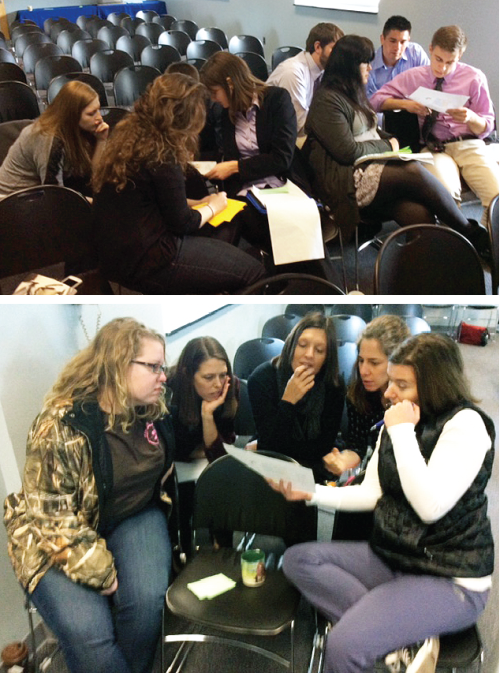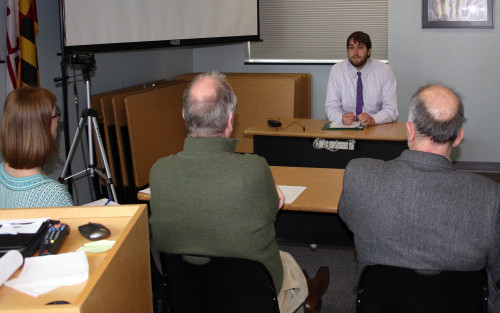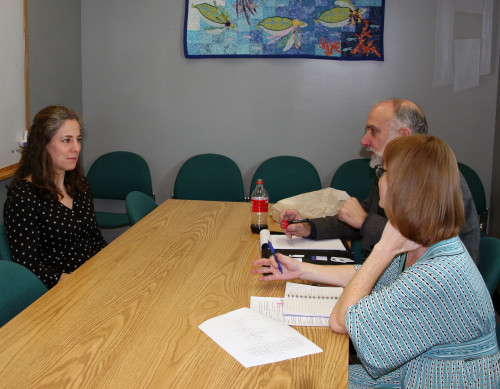Talking with graduate students about how to get a job
Bill Dennison ·At the request of graduate students in the Marine Environmental and Estuarine Science (MEES) program at the University System of Maryland, the Horn Point Laboratory and the second workshop was at Chesapeake Biological Laboratory (CBL), University of Maryland Center for Environmental Science (UMCES). This blog describes the second workshop, conducted on 12 February 2016. I was assisted by Tom Miller (CBL Director), Guy Stephens (UMCES @ Chesapeake Bay Program), Jamie Testa and Dylan Taillie (IAN).
The professional development workshop topics included how to a) prepare for a job search, b) assemble an application package, c) produce a curriculum vitae, and d) interview well. I presented some guidance about each of these topics, reviewed materials that the students had submitted beforehand and conducted several exercises. Since Guy Stephens was serving on the interview panel, I asked him to take professional photographs of each student that they could use on their LinkedIn or ResearchGate accounts, as well as begin to develop a strong web presence.

In preparing for a job search, I encouraged students to begin looking at job advertisements to help develop a feel for the type and availability of jobs that would be interesting. I also encouraged developing career mentors, proactively improving their communication skills, integrate at every opportunity, talk with scientists, attend workshops, conferences and seminars, and read widely. I also emphasized that personal contacts are invaluable, volunteer efforts often lead to jobs, and to keep trying, since it often takes multiple attempts to land the right job.
For assembling a job application package, the primary goal is to be invited for an interview. I emphasized that all correspondence and phone calls are part of the application package, which should be professional, succinct and clear. Emails and cover letters should be regarded as important as the curriculum vitae and we reviewed examples of good job application emails and cover letters. I also emphasized the importance of doing your homework about a prospective job. Learning as much about the organization that you are applying to and the people that you would be working with is invaluable.

In developing a curriculum vitae, I contrasted a curriculum vitae or CV (from Latin for "the course of my life") from a shorter, more narrative resume (French for "summarized"). The primary goal of the CV is to provide relevant information to a prospective employer. The CV should be individually tailored to each job application, free of typos or grammatical errors, and be complete enough to give prospective employers sufficient background of one's abilities. I reviewed many CVs as to what constituted strong practice.
The first exercise was to develop a short "elevator speech" about their thesis projects using the " . . . AND . . . BUT . . . THEREFORE . . ." (ABT) rubric [youtube] developed by Randy Olson . I found it interesting that students invariably produced an ABT statement addressing the question of "Why?" they were conducting their research, rather than focusing on what they had found. This is partially a result of the status of their thesis research, and the distillation of what it all means only comes near the final stages of writing their thesis or dissertation. The students who attended the 2015 MEES Colloquium had already been exposed to the ABT statements, but all students did a good job of summarizing their research.

Another exercise was "Title Pursuit" in which students are presented with a PowerPoint slide with data, but no title. The exercise is to wordsmith a clear and concise title, which explains the main result. Students mastered this exercise quickly, which was encouraging.
The final exercise that took the most time was to conduct mock interviews. Students nominated which type of job interview they would be pursuing (e.g., academic position, state agency position) and we formed an appropriate interview panel. We filmed students during each mock interview so that they can review their performance and we also provided feedback after each interview. The interview feedback included interview panel introductions, body language, eye contact and listening skills. Overall, I was impressed at the professionalism displayed by the students and their ability to answer interview questions. One aspect that the students need to work on is the questions they should be asking during the interview.

Overall, I am glad that the students requested this workshop, as I enjoyed putting together the workshop materials and enjoyed the mock interviews. The invaluable assistance from Tom Miller and the IAN team made the workshop activities fun and informative. I added a few slides about what some of the stellar MEES alumni are doing with their careers, and based on what I saw at these workshops, I'm confident that many the our current MEES students will be doing some equally amazing things in the future.
About the author
Bill Dennison

Dr. Bill Dennison is a Professor of Marine Science and Vice President for Science Application at the University of Maryland Center for Environmental Science.

